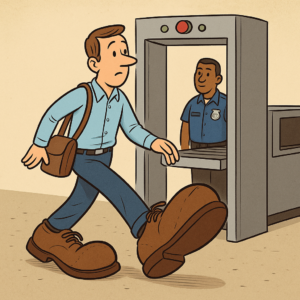TSA’s Slow Evolution Finally Accelerates
For over two decades, airport security lines in the United States have shared a universal ritual: take off your shoes, pull out your liquids, and hope for the best. It has been inconvenient, undignified, and largely unquestioned. But in July 2025, one of those rituals came to an end—and another may soon follow.
The TSA officially ended its mandatory shoe removal policy, a requirement that had defined post-9/11 airport security for generations of travelers. And in the same breath, officials hinted that the long-dreaded 3-1-1 liquids rule—a regulation born from a 2006 terror plot—might be next on the chopping block.
Why You Can Finally Keep Your Shoes On
As of July 8, 2025, travelers at all U.S. airports no longer have to remove their shoes at standard security checkpoints. This change, once unthinkable, is the direct result of new CT (computed tomography) scanners being deployed nationwide. These 3D scanners allow TSA officers to better detect threats inside shoes without passengers having to remove them.
It’s not just a technical victory—it’s a symbolic one. The shoe rule, introduced after Richard Reid’s failed “shoe bomb” attempt in 2001, has long stood as a poster child for the reactive, one-size-fits-all nature of American security policy. Now, it’s officially history.
A Shift in Tone—and Trust
In announcing the change, DHS Secretary Kristi Noem framed it not just as a convenience, but as a new philosophy. “We can protect passengers and still respect their time and dignity,” she said. That message—radical in its simplicity—suggests a broader rethinking of how Americans experience airport security.
The rollout of CT scanners across major hubs has been central to this transformation. These machines are now in over 250 airports and are expected to reach most high-traffic terminals by 2026. They don’t just keep your shoes on—they also allow laptops and liquids to remain in bags, at least in TSA PreCheck lanes. And that’s where the next potential shift lies.
Will the Liquids Rule Be Next?
The 3-1-1 liquids rule has governed American carry-on bags since 2006: each passenger is allowed one quart-sized bag of liquids, gels, or aerosols in containers of 3.4 ounces or less. This rule emerged in response to a British plot involving liquid explosives. But as security tech has advanced, critics have increasingly questioned whether the rule still serves a purpose—or simply survives out of habit.
Secretary Noem, when pressed, said DHS is actively reviewing the liquids restriction and “hopes to have something to say soon.” It’s not a promise, but it’s the strongest signal yet that the rule may soon be revised—if not eliminated altogether.
Not So Fast: Infrastructure Is Key
Of course, not every checkpoint is ready for a post-liquid-rule world. While CT scanners are becoming more common, many smaller airports still rely on outdated X-ray machines that require a clearer view of each item. And even at large airports, staffing, training, and standardization will take time to catch up.
So don’t throw out your travel-size shampoo just yet. For now, the liquids rule remains in effect nationwide—though a phased relaxation at major airports seems increasingly plausible.
A Long Time Coming
FlightWisdom has covered the TSA’s slow modernization for years, from the rollout of PreCheck and Global Entry to the first trials of CT scanners. And we’ve been skeptical about “security theater”—those procedures that frustrate more than they protect.
This moment is significant because it suggests that the TSA is finally prioritizing evidence-based policy over outdated optics. The shoe removal rule was one of the most visible symptoms of a reactive era. Ending it sends a signal that perhaps we’ve entered a more pragmatic phase.
What It Means for You
- Shoes: Stay on for all passengers, not just PreCheck.
- Liquids: Still limited to 3.4 oz for now—but watch this space.
- CT Scanners: More airports are getting them every month; they improve detection and reduce hassle.
- PreCheck: Still worth it for faster lines and more relaxed protocols, especially where CT scanners are not yet in place.
Looking Ahead
Change at the TSA is notoriously slow. But change is clearly happening. The agency’s leadership is now publicly talking about flexibility, modernization, and passenger dignity—terms rarely heard a decade ago.
If and when the liquids rule falls, it will mark the end of the last truly disruptive rule still affecting every air traveler. For once, the next chapter in airport security may not be more inconvenience. It might be a return to common sense.
